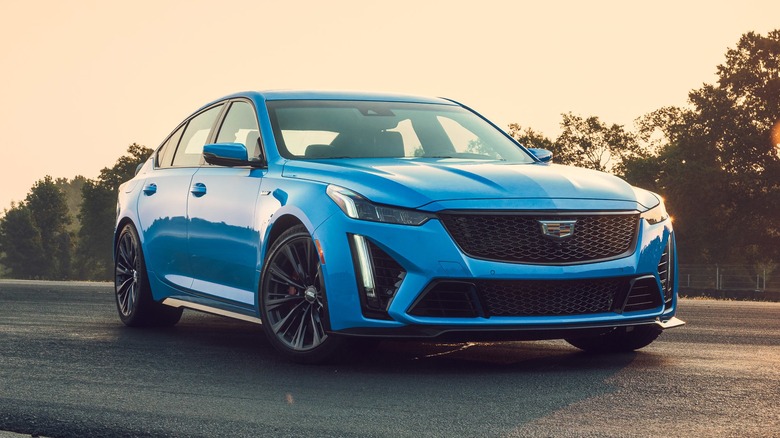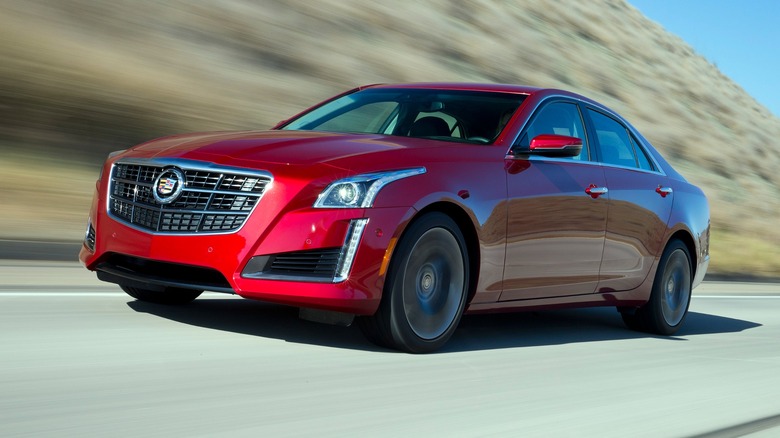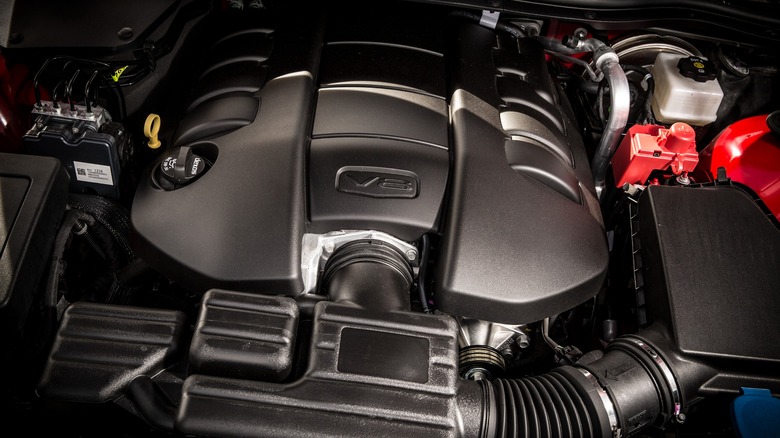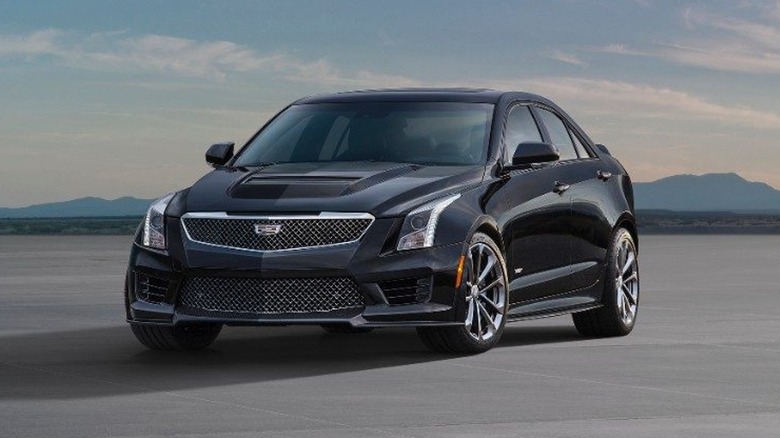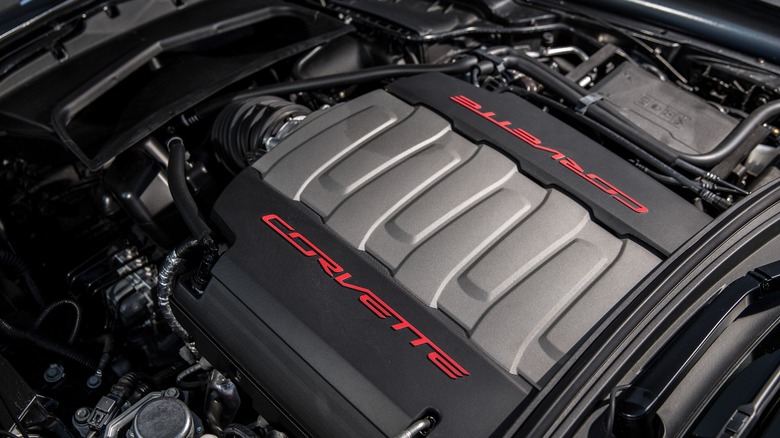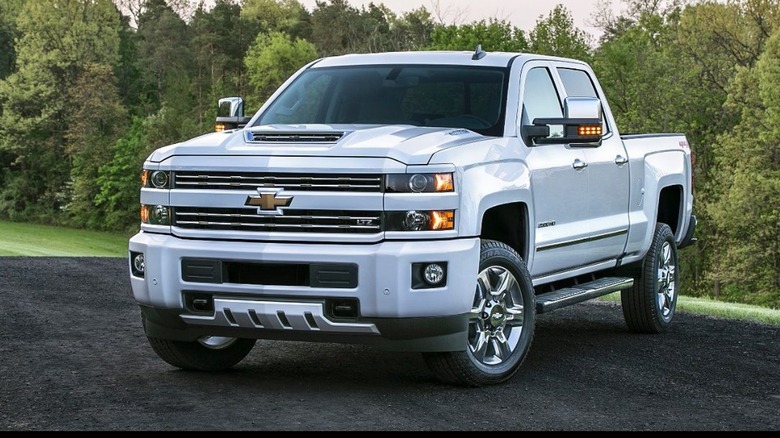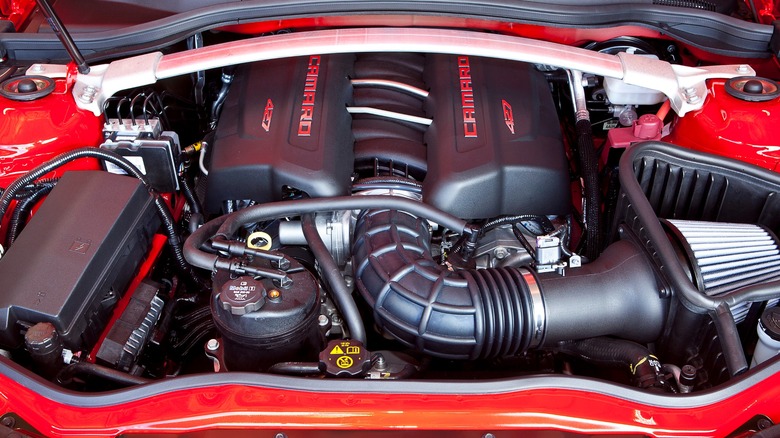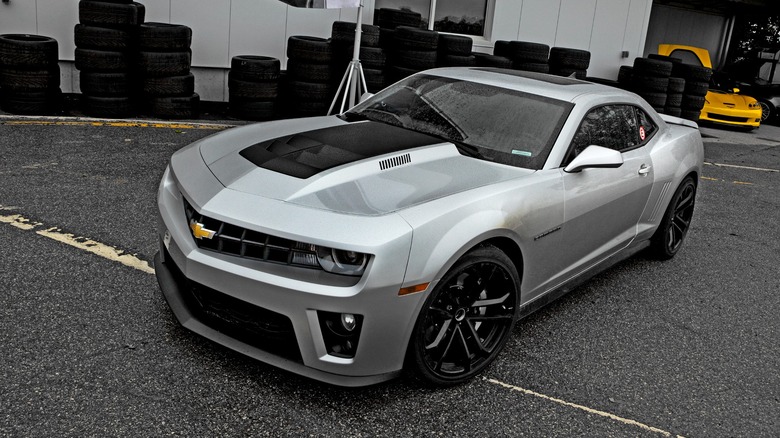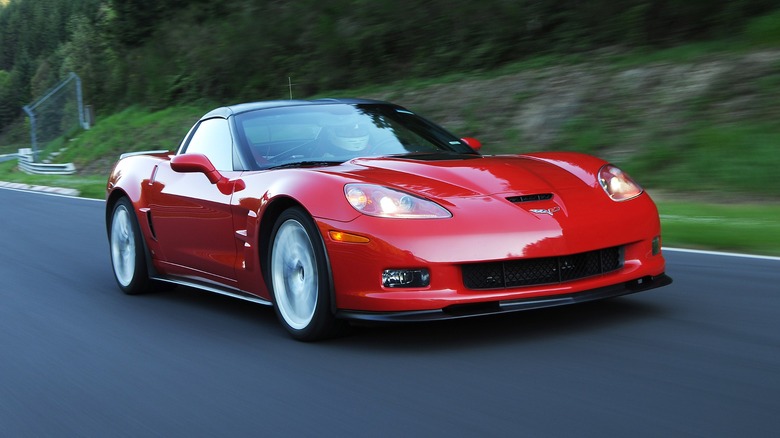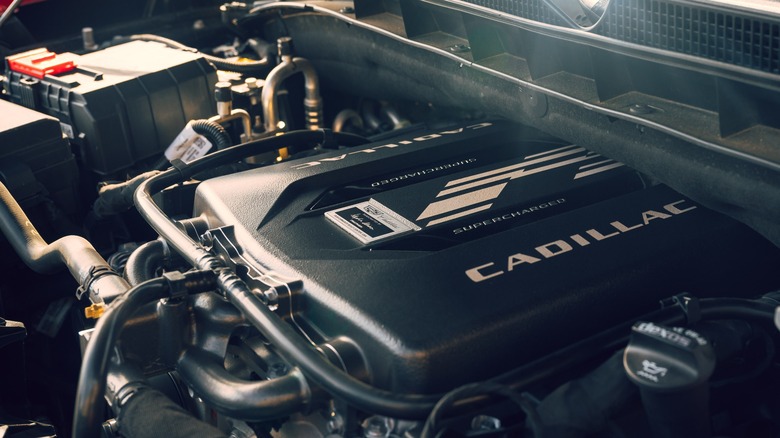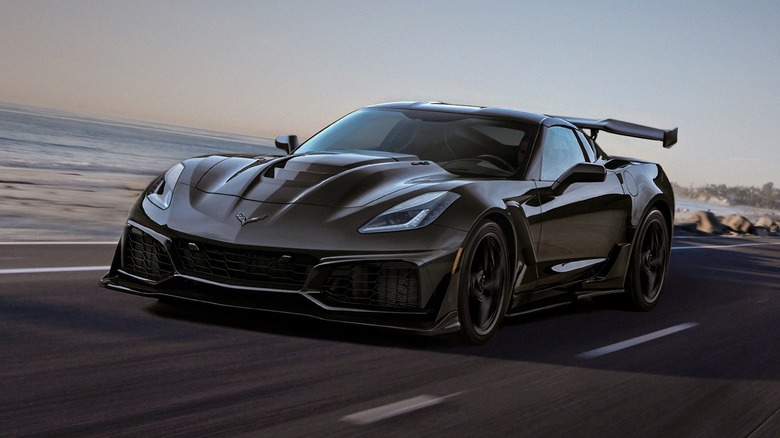10 Of The Most Powerful Engines Ever Built By General Motors, Ranked
General Motors has a long history of producing powerful engines that push the boundaries of innovation and performance. In this piece, SlashGear delves into some of the company's creations, with a focus on exceptional engine output. GM's roster boasts some real raw power, with the most potent engines producing over 400 horsepower and culminating in a staggering 772 horsepower. While the iconic small-block V8 engines take center stage, some of the remarkable contenders in this arena include the twin-turbocharged V6 and the formidable Duramax turbo diesel.
Each step of this scale represents a distinct engine, demonstrating GM's commitment to innovation. This journey isn't just about numbers; it's also about the relentless pursuit of speed. These engines' legacies continue to inspire, from the LT5's use of GM's first dual injection system to the LF3's first implementation of twin turbocharging in a V6. Prepare to be surprised as we unveil the hidden gems and established legends in General Motors' engine lineup.
10. 3.6-Liter Twin-Turbocharged V6 LF3 -- 420 HP
Cadillac introduced the LF3 engine in the 2014 Cadillac CTS Vsport and XTS Vsport sedans. This was Cadillac's first twin-turbocharged engine with an architecture based on the LFX, a naturally aspirated 3.6-liter V6. The LF3 inherited LFX's proven technologies like direct injection, variable valve timing, and dual overhead camshafts. However, unlike the LFX, the LF3 also had a lot of new components, making it the most potent V6 from Cadillac at the time, with 118 horsepower per liter.
In the XTS Vsport, the 3.6-liter V6 LF3 produced 410 horsepower and 369 lb-ft of torque. It paired with a six-speed automatic transmission, powering all four wheels. The Cadillac CTS Vsport upped the performance to 420 horsepower and 430 lb-ft of torque. Unlike the XTS, it used an eight-speed automatic transmission, powering the rear wheels. This resulted in a reasonably quick 0-to-60 mph run of 4.6 seconds. To help make the engine deliver constant power, Cadillac opted for two smaller turbochargers and an efficient charge air cooler. This also helped the engine deliver around 90% torque from 2,500 to 5,000 rpm.
The LF3 also shared a similar design with the 6.2-liter LSA V8, helping make it more effective and efficient. These enhancements and performance figures made the LS3 better than competitors like the BMW 535i, which had a turbocharged 3.0-liter six-cylinder with 300 horsepower and 300 lb-ft of torque. Surprisingly, the V6 LF3 engine also had better horsepower per liter than BMW's turbocharged 4.4-liter V8 in the 550i, which had 101 horsepower per liter. The BMW's larger displacement and more horsepower only made the 550i 0.1 seconds faster than the CTS Vsport from 0 to 60 mph.
9. 6.2-Liter V8 LS3 -- 436 HP
General Motors' LS3 engine is a 6.2-liter V8, a direct descendant of the small-block engine. Chevrolet introduced the LS3 in the 2008 Corvette, featuring improved intake and exhaust flow for better efficiency and performance. In the Corvette, the LS3 produced 430 horsepower and 424 lb-ft of torque, impressive figures at the time. This translated to a quick 0 to 60 mph acceleration time of 4.5 seconds, a standing quarter-mile time of 12.8 seconds, and a top speed of 190 mph. This helped the Corvette outperform rivals like the more expensive 2008 Porsche 911, which used a 3.8-liter six-cylinder engine with 355 horsepower and 295 lb-ft of torque.
Chevrolet also offered an optional sport exhaust system, which improved performance by six horsepower and 4 lb-ft of torque. The sport exhaust system used vacuum-actuated outlet valves, similar to that in the Z06 and ZR1, offering a more aggressive exhaust note and boosting performance. In addition, Chevrolet also fitted the LS3 in the 2010 Camaro, churning out 426 horsepower and 420 lb-ft of torque. This helped the Camaro charge from 0 to 60 mph in five seconds flat, outperforming rivals like the Challenger STR8 and Mustang GT.
Despite being a high performer, the LS3 engine in the 2008 Corvette had a reasonable EPA fuel economy rating of 16 mpg city, 26 mpg highway, and 19 mpg combined. Chevrolet also fitted the LS3 in the 2015 to 2017 SS sedan, producing 415 horsepower and 415 lb-ft of torque. While it didn't have the Corvette's or Camaro's performance, the SS could sprint from 0 to 60 mph in about 5.0 seconds.
8. 3.6-Liter Twin-Turbocharged V6 LF4 -- 464 HP
For the 2016 model year, Cadillac introduced the LF4 engine, a more powerful and fuel-efficient variant of the LF3. The LF4 retained the same displacement and was used in the 2016 Cadillac ATS-V sedan and coupe, making them the first-ever Cadillac V-series models with twin-turbo engines. It had 464 horsepower and 444 lb-ft of torque, sending it to the rear wheels through a six-speed manual or an eight-speed automatic transmission. This impressive performance enabled the Cadillac ATS-V to dash from 0 to 60 mph in 3.8 seconds and get to a top speed of 184 mph.
In addition to its performance increase, the LF4 matched the fuel economy figures of the LF3 in the 2014 Cadillac XTS Vsport, managing an EPA rating of 16 mpg city, 24 mpg highway, and 19 mpg combined. Cadillac outfitted the LF4 with unique features like a low-volume charge air cooler, titanium connecting rods, and low-inertia titanium aluminide turbines. These features helped with power delivery, providing around 90% peak torque from 2,400 to 6,000 rpm. Cadillac's use of low-inertia turbines helped the twin turbochargers offer precise and responsive torque by minimizing the rotating inertia load by 51%.
All these improvements helped the LF4 outperform rivals like the 2016 BMW M3, which boasted a turbocharged 3.0-liter six-cylinder engine with 425 horsepower and 406 lb-ft of torque. GM also produced a racing version of the LF4 engine, the LF4.R. The engine powered the ATS-V.R, featuring larger turbochargers, a side-exiting exhaust, and increased capacity intercoolers, resulting in an impressive 600 horsepower.
7. 6.2-Liter V8 LT1 -- 460 HP
GM produced the LT1 engine for use in sports cars and performance vehicles. The LT1 was the successor to the LS3 engine and featured advanced technologies like active fuel management, direct injection, and continuously variable valve timing. The LT1 made its debut in 2014, powering the Corvette Stingray. It marked the third small block engine in a Corvette and produced an impressive 455 horsepower and 460 lb-ft of torque.
Like the LS3-powered Corvettes, Chevrolet also offered an optional performance exhaust, which upped the performance to 460 horsepower and 465 lb-ft of torque. The use of the LT1 engine in the Corvette made it one of the most capable models at the time, boasting a quick 0-to-60 mph time of 3.8 seconds and a quarter-mile run of 12 seconds with the Z51 package. Surprisingly, the LT1 also had great fuel economy, managing an EPA rating of 17 mpg city, 28 mpg highway, and 21 mpg combined. On the other hand, rivals like the 2015 BMW M4 had lower fuel economy ratings despite using a turbocharged three-liter, six-cylinder engine with 425 horsepower and 406 lb-ft of torque.
Using the LT1 engine helped make the Corvette Stingray one of the most efficient sports cars at the time. Chevrolet also introduced the LT1 in the sixth-generation Camaro, boasting 455 horsepower and 455 lb-ft of torque, better performance than the predecessor's LS3 engine. At the time, this made the V8-powered Camaro the most powerful Camaro SS ever.
6. 6.6-Liter V8 Duramax Turbo Diesel L5P -- 470 HP
The 6.6-liter L5P V8 is a high-performance diesel engine for heavy-duty pickup trucks. The L5P is among the newer Duramax engines, succeeding the LML V8 engine. General Motors introduced the L5P engine in 2017, powering the Sierra and Silverado HD trucks. Upon launch, the engine produced an impressive 445 horsepower and 910 lb-ft of torque, but nowadays, the 2024 trucks boast 470 horsepower and 975 lb-ft. This makes it more powerful than the standard 6.6-liter L8T V8 gasoline engine with 401 horsepower and 464 lb-ft of torque.
GM's L5P engine boasts the next-generation design with a rotating assembly, improved cylinder head design, new camshaft profile, and a stronger cylinder block. The L5P also uses a vehicle air intake system, providing cooler engine temperatures and sustained performance in strenuous conditions. This helps make the L5P a better rival to Ram's 6.7-liter turbodiesel engine, which powers the 2500 and 3500 trucks. That six-cylinder diesel produces up to 400 horsepower and 1,000 lb-ft of torque.
5. 7.0-Liter V8 LS7 -- 570 HP
The LS7 is one of the few engines assembled by hand. The LS7 was the successor to the LS2 engine, providing smooth and consistent power delivery. Like most high-performance V8 engines, the LS7 was first introduced in the C6 Corvette Z06, producing an impressive 505 horsepower and 470 lb-ft of torque. With such performance, the Corvette could accelerate from 0 to 60 mph in 3.7 seconds, reach a top speed of 198 mph, and achieve a quarter-mile time of 11.7 seconds.
Chevrolet later introduced the LS7 in the fifth generation Camaro Z/28, retaining the horsepower figure but upping the torque to 481 lb-ft. These impressive performance figures helped make the LS7 one of the most powerful naturally aspirated engines of its time. To take full advantage of the LS7 motor, Chevrolet designed it for high-rpm environments, fitting high-flow cylinder heads, titanium connecting rods, and a forged steel crankshaft. The LS7 also had a dry sump oil system to provide sufficient oil pressure when cornering.
In both the Corvette and Camaro, the LS7 was paired with a six-speed manual transmission, strengthened to handle the increased torque load. The LS7 also had reasonable fuel economy figures, with the 2006 Corvette managing an EPA rating of 15 mpg city, 24 mpg highway, and 18 mpg combined. While Chevrolet discontinued the engine in 2015 with the last Camaro Z/28, the LS7 is still available as a crate engine, boasting 570 horsepower and 540 lb-ft of torque. This version includes a higher lift camshaft and a wet sump oil system, boosting performance and helping with easier installation.
4. 6.2-Liter Supercharged V8 LSA -- 580 HP
The LSA was produced for use in high-performance vehicles. It was first introduced in the 2008 Cadillac CTS-V lineup, producing 556 horsepower and 551 lb-ft of torque. Cadillac's CTS-V lineup had three body styles: a coupe, wagon, and sedan. General Motors used premium aluminum alloy cylinder heads and an intercooled supercharger system, helping the LSA deliver quiet and smooth performance. The supercharger also had a quiet four-lobe rotor design.
Chevrolet also used the LSA in the 2012 Camaro ZL1, upping its performance to 580 horsepower and 556 lb-ft of torque. This enabled the Camaro to scramble from 0 to 60 mph in 3.9 seconds and reach a top speed of 184 mph. Chevrolet's lower starting price of $54,995 helped the Camaro rival more expensive sports cars like the 560-horsepower Audi R8 GT and 565-horsepower Mercedes SLS AMG, with base prices of $196,800 and $185,750, respectively. Chevrolet also added a free-flowing dual-mode exhaust system with a refined exhaust note thanks to vacuum-accentuated valves.
The Cadillac and Chevrolet models paired the LSA with a six-speed manual or automatic transmission. Despite being a high-performance engine, the LSA had better fuel economy ratings of 14 mpg city, 19 mpg highway, and 16 mpg combined, compared to the V10-powered 2012 Audi R8 with 12 mpg city, 19 mpg highway, and 14 mpg combined.
3. 6.2-Liter Supercharged V8 LS9 -- 638 HP
When Chevrolet introduced the LS9 in the Corvette ZR1 in 2009, it was General Motors' most powerful production engine. The LS9 helped the Corvette ZR1 produce 638 horsepower and 604 lb-ft of torque. Chevrolet used a twin-rotor Eaton supercharger with a four-lobe rotor design, giving the LS9 a broad performance range. The LS9 also had a charge cooling system, which boosted performance by reducing inlet air temperature. Like some of its V8 siblings, the LS9 was hand-assembled at GM's Performance Build Center and had specialty processes common in racing engines to help promote its overall performance.
In the Corvette, the LS9 was paired with a stronger six-speed manual transmission to handle the additional power. The transmission also had a twin disc clutch, offering easy clutch pedal effort and great clamping power. All these performance components helped make the ZR1 the first production Corvette to have a top speed of over 200 mph. The Corvette could do 205, matching the fastest street-legal 911 at the time, the 997 911 GT2.
The Corvette ZR1 also had a good EPA fuel economy rating of 14 mpg city, 20 mpg highway, and 16 mpg combined, better than rivals like the Lamborghini Murcielago and the Ferrari 599. Despite the LS9 being only available from 2009 to 2013, Chevrolet still offers it as a crate engine, promising ZR1 performance.
2. 6.2-Liter Supercharged V8 LT4 -- 682 HP
The LT4 engine is a 6.2-liter unit with a purpose-built supercharger and eight cylinders. Chevrolet introduced the LT4 in the C7 Corvette Z06, making it the first Z06 to use a supercharged engine. This Corvette Z06 was also the first model with a removable roof panel for coupes and a paddle-shift automatic transmission. The LT4 engine produced 650 horsepower and 650 lb-ft of torque, pushing the Corvette performance envelope to new levels. This also helped make the Z06 one of the most powerful production cars in the U.S. and GM's most powerful production car at the time.
The C7 Z06, with the optional Z07 package, could gallop from 0 to 60 mph in 2.95 seconds with the automatic transmission and set a quarter mile time of 10.95 seconds. The manual transmission Z06 was still fast, managing the 0-to-60 run in 3.2 seconds and the quarter-mile in 11.2 seconds. In 2016, Cadillac fitted the LT4 in the CTS-V, producing 640 horsepower and 630 lb-ft of torque. These performance figures of the LT4 helped the CTS-V achieve a 0-to-60 time of 3.7 seconds and reach a 200-mph top speed. Surprisingly, this made the Cadillac better than Mercedes-Benz vehicles with the biturbo 5.5-liter V8 and BMW M models with the biturbo 4.4-liter V8.
Nowadays, the LT4 powers various high-performance vehicles, including the Camaro ZL1, Cadillac CT5-V Blackwing, and the Escalade-V. While the Camaro ZL1 still produces 650 horsepower and 650 lb-ft of torque, the CT5-V Blackwing ups the performance to 668 horsepower and 659 lb-ft. Cadillac's Escalade-V takes the crown, boasting an impressive 682 horsepower and 653 lb-ft of torque.
1. 6.2-Liter Supercharged V8 LT5 -- 772 HP
The LT5 is a supercharged V8 motor used exclusively in the C7 Corvette ZR1. The LT5 is similar to the LT4 in the C7 Corvette Z06 and the modern Camaro ZL1. However, to up the LT5's performance, General Motors fitted it with a larger throttle body, a new dual fuel-injection system, a stronger crankshaft, and a larger supercharger with 52% more displacement than the LT4's variant. Chevrolet introduced the LT5 V8 in the 2019 C7 Corvette ZR1, with a starting MSRP of $121,995. The Corvette ZR1 was available as a coupe with a removable roof or as a convertible.
Thanks to the LT5 using GM's first dual fuel-injection system, the C7 Corvette ZR1 produced an impressive 755 horsepower and 715 lb-ft of torque. Chevrolet offered the LT5 with a seven-speed manual transmission as standard. However, for the first time in the ZR1, Chevrolet offered an optional eight-speed automatic. The potent engine and the aggressive design helped make the Corvette ZR1 the fastest production Corvette with a 210-mph top speed. Chevrolet Performance also offered a C7 air intake, which upped the ZR1's output to 772 horsepower.
